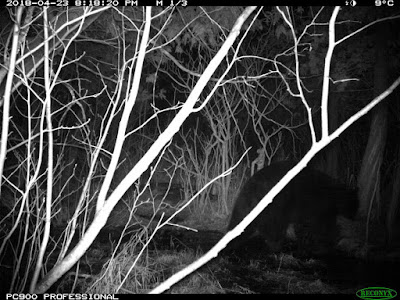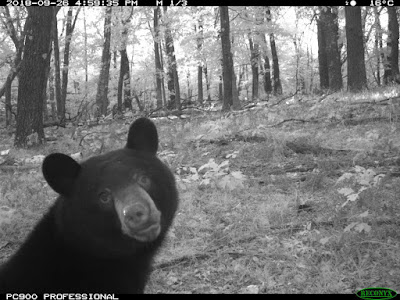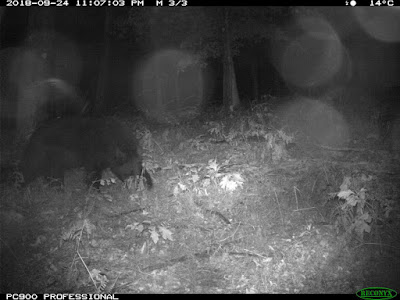Minnesota Black Bears
Generously written by Sue Mansfield, who completed her master's degree studying black bears in northeastern Minnesota. Specifically, she did her thesis fieldwork at the Wildlife Research Institute (WRI) in Ely, MN. After completing her thesis, she continued working at WRI and helped develop the North American Bear Center in Ely, MN. Sue is also an accomplished tracker and is a contributor to the book "Mammal Tracks and Sign: A Guide to North American Species." She is currently active with the Minnesota Wildlife Tracking Project and participates in seasonal track and sign surveys at Cedar Creek as part of the Cedar Creek Wildlife Survey.
Over the millennia, American black bears have adapted to varied forested habitats throughout North America. The timing of hibernation, mating, hyperphagia, etc. vary throughout their range based on the local norms of wild food availability. Bears in northern regions hibernate longer and have just a few short months to fatten up before their next hibernation. In southern regions, pregnant females den up until their cubs are mobile—but other southern bears may or may not den if food is available. The size of black bear territories varies by region as well—scarce wild foods equate to larger territories. Female offspring generally take over part of their mother’s territory or establish a territory nearby. Male offspring typically move away from their mother’s territory by age 2. The following is an outline of a typical year for black bears in Minnesota where mature female territories are about 6 square miles and mature male ranges encompass 5-7 female territories.
Minnesota’s black bear cubs are born during the coldest part of winter—mid-January thru early-February. Their mothers are awake and alert during labor and may even leave the den to gather conifer boughs as additional bedding prior to giving birth. Three is the most common litter size for older females, but first litters are generally smaller. Cubs are born weighing less than a pound with eyes closed. Their ears are just flaps folded tight to the head and their bodies are covered with short velvety fur. Their mother hovers over them to keep them warm and guide them to her nipples. She periodically licks them to stimulate the elimination of wastes, which she then consumes. This keeps the den clean and any nutrients are recycled and used by the mother. Initially, cubs eat, sleep, and grow while tucked safely under their mother. Once their fur grows in, they can sometimes be seen crawling and sleeping on their mother. Cubs’ eyes open at 6 weeks—and the fun begins! Once eyes are fully open, cubs add exploring and playing to their “eat, sleep, and grow” regime and individual cub personalities become evident. As mothers convert their fat reserves to rich milk for their growing cubs, they lose 40-45% of their fall weight. By contrast, male bears and females without new cubs lose 18-20% of their fall weight over winter.
Females with cubs generally leave their dens in mid-April and rake leaf litter into a bed at the base of a large tree—often a white pine. She begins “reclaiming” her territory by marking—back-rubbing trees, dripping urine, and stomping as soon as the family leaves the den area. Her cubs hone their climbing skills on the bed tree as their mothers forage nearby on roots, catkins, buds, grubs, and snowfleas. Early spring bed sites are often near swampy areas where willows and wild calla are found. This meager fare is the first food the mother has eaten in 7 months. It supplies important nutrients, but she will not begin to gain weight until the summer berry season. Cubs are still dependent on their mother’s milk but begin to sample solid foods as soon as they leave the den. They constantly follow their noses and mouth everything. Their mother may continue to lick them to stimulate elimination for a week or so after they leave the den. The cubs gradually become resistant to this “intrusion” as they would rather be playing and exploring with siblings.
Mature males are generally the first to begin roaming in the spring. Their testosterone levels are high and they begin advertising their presence by rubbing and biting trees and utility poles within their mating range. They also straddle shrubs and saplings—dribbling urine as they pass over them. Bear trails (distinct impressions made by bears stomping their feet) develop leading to and from well-used marking trees/poles. Mature males forage in the spring on available foods but around mid-May mating takes priority. Consequently, they may lose as much weight during the 6-week mating season as they did over winter. For example: A mature male entering his den in the fall weighing 500 lbs will leave the den weighing 400 lbs, and will weigh 300 lbs by the end of mating season.
Females with yearling cubs (cubs from the previous year) are free to roam and forage throughout their territory in early spring because the yearlings can easily keep up with their mother. These mothers are coming into estrus and advertise their availability as they move through their territory by rubbing their genitalia on logs, mounds of vegetation, and may even climb trees to rub on branches. They weaned their young the previous fall before entering the den, but their yearlings suckled (without obtaining milk) in the den during the winter. Within a week or 10 days of leaving the den in the spring, healthy mothers are able to resume lactation. They continue to nurse their yearlings right up to family breakup which usually occurs mid-May thru early-June.
Family breakup takes many forms, but the most common scenario is “male-instigated” breakup—a mature male arrives on the scene, the female consents to his presence, and the yearlings (who have been taught to fear large males) choose to leave. The male and the mother may both show aggression towards the yearlings to reinforce their decision to leave. Some older females have favorite mates and are intolerant of other males as they wait for their favored suitor to arrive.
Mating season coincides with spring green-up when nutrient-rich vegetation is abundant. Courtship can last 8-10 days for a mature female who has just separated from her yearlings. During that time, the female roams and forages throughout her territory while the male follows—keeping her in sight and occasionally approaching to test her readiness to mate. She tolerates his presence but squirms away if he gets too pushy before she is ready. The male lies down to conserve energy as he watches the female forage. If the female beds down, the male will lie close and may even be touching the female. This allows him to sleep—knowing his mate won’t be able to sneak off. Males can be twice as large as females and mated pairs are often mistaken for mother and cub by inexperienced observers. Mating itself may last an hour with the female seemingly disinterested in the process. The male may guard the female after mating to ensure she does not run off and mate with another male. It is believed that black bear females are induced ovulators—i.e. copulation stimulates ovulation. Females may mate with multiple males and a single litter can have multiple fathers. Once a female has been successfully impregnated she is no longer attractive to males and they ignore her in favor of other females still in estrus. By the end of June, mating season has ended for most females. Younger females are generally the last to be bred.
Black bears have delayed implantation. Once the eggs are fertilized, they develop to the blastocyst stage but do not implant in the uterine wall until November when the female is in her den and well into her hibernation state. Implantation occurs only if the female has enough body fat to birth and successfully nurture cubs in the den.
Black bears shed their fluffy winter coat early in the summer and it is replaced with short guard hairs that lie close to the body giving the bears a sleek appearance. Even cubs replace their fuzzy cub fur with a sleek coat. Lactating females are the exception. Possibly due to the demands of lactation, they are slower to lose their winter coats and appear shaggy in the early summer.
Mothers with new cubs begin to roam during green-up—often concentrating activities around a single bed tree for several days before moving on to another area and another bed tree. As cubs mature and wild foods become more available, the family moves further each day and seldom reuses bedsites on consecutive days. Family units are often surprisingly spread out as mothers and cubs roam and forage, but mothers respond immediately to any cub cry. However, if each family member is foraging contentedly, it may appear to the casual observer that the mother is inattentive.
Contrary to the common belief that mother bears keep their cubs in line, cubs seem to get their way most of the time. If they are high in a tree when their mother wants to move on, she will grunt for them to come down. However, they come down when they are ready—and it could be hours later. When cubs challenge their mother for food—such as a choice ant log—she will back off and let them have it. However, she controls the “milk wagon” and can manipulate her cubs to follow her by lying down to nurse them and then walking away just as they settle in. Her whining cubs scramble to follow. Mothers also use play to get dawdling cubs moving.
As the wild berries begin to ripen, mating season ends and hyperphagia begins. Mature males become more tolerant of each other and younger males may even buddy-up to forage and play together. During hyperphagia, bears may forage up to 20 hours a day. Where food is concentrated, bears may conserve energy by lying down to feed. Mature males can gain as much as 7 pounds a day as they work to regain the weight they lost over winter and during mating season. Within families, foraging takes precedence over play and exhausted cubs fall asleep without playing during the brief nursing/rest breaks. Pregnant females are able to fatten quickly, but mothers with cubs are slower to gain weight due to the demands of lactation. They also do not need to gain as much weight because their over winter weight loss will be only 18-20%—compared to the 40-45% loss the previous winter when they give birth.
Bears begin to grow their winter coats in mid-August. Guard hairs lengthen and dense underfur grows in to prop up the guard hairs—giving bears a 3-4 inch thick winter coat and a whole new appearance. All bears appear fat whether they really are or not.
Weaning also begins in the late summer or early fall. Mothers refuse requests to nurse by lying on their nipples and may even lunge and blow at persistent cubs. However, a mother will occasionally allow nursing to happen—likely to ease her discomfort. This is confusing for the cubs, and their persistent bawls are pitiful.
Pregnant females are the first to abandon available foods and move to their den site. In northern Minnesota, well-fed pregnant females may move to their denning area as early as the first week in September. Mature males are the next group to den. Young adult bears and mothers with cubs forage longer if food is available. Older bears would expend more energy foraging on scattered foods than they could obtain from that food. However, younger bears with less body mass can still benefit from dwindling food resources. Their growth rate and sexual maturity depend on food intake. The faster females grow, the sooner they will reproduce. The faster males grow, the sooner they will be able to compete successfully with other males for mates.
Bear dens take many forms. Bears readily use the hollow created by the roots of leaning or fallen trees. These are referred to as “throwmound” dens. Dens may be dug under the roots of large trees or groups of smaller trees—with the roots helping to form the roof of the den. Natural rock dens are favored and are commonly reused. Bears also den in brush piles and may even simply bed at the base of a tree for the winter. Their winter coat is highly insulative and snow will accumulate on it without melting. Most bears rake bedding into their dens. Bedding may consist of leaf litter, grass, moss and conifer boughs gathered from up to 20 feet away from the den. Some dens are chosen long before fall arrives. A 3-year-old pregnant female was observed digging a den on July 19. She gave birth to her first litter of cubs in that den the following January. As bears move about their territory throughout the spring and summer, they seldom miss an opportunity to explore potential dens. As such, they can move to another den if they are disturbed during hibernation. Most Minnesota bears are in dens by the middle of October.
The year ends with bears snug in their dens. Blastocysts have implanted in the uterine walls of well-fed females that bred last spring. Bear metabolism slows and body temperature drops as bears enter hibernation. The depth of their hibernation depends on fat reserves. Bears with meager fat reserves fall into a deep sleep and are hard to rouse. Well-fed bears sleep lightly and are well aware of approaches to their dens. During the coldest days of winter, bears curl into a tight ball with their nose and face tucked underneath them—only the densest portion of their winter coat is exposed. On warmer days they relax and stretch out a bit. Bears may reach out of their dens to lick snow and eat ice. In general, bears do not urinate or defecate during their winter hibernation, but exceptions to this have been observed in well-fed female bears. In a few short weeks, there will be new life in the den and the lifecycle of Minnesota’s black bear continues.
Below is a list of common Minnesota bear foods. This list is by no means exhaustive.
FOOD
|
SCIENTIFIC NAME
|
NOTES
|
Nuts
| ||
American hazelnut
|
Corylus americana
| |
beaked hazelnut
|
Corylus cornuta
| |
acorn
|
Quercus spp.
|
white oak acorns are preferred, red oak family acorns also eaten
|
Vegetation
| ||
maple seeds
|
Acer spp.
|
newly emerged tender seeds
|
speckled alder
|
Alnus incana
|
green cones in summer, leaves in fall
|
Jack-in-the-pulpit
|
Arisaema triphyllum
|
leaves, root
|
wild calla
|
Calla palustris
|
leaves, stems, roots, seed heads
|
bull thistle
|
Cirsium vulgare
|
heart
|
horsetail
|
Equisetum spp.
|
newly emerged stems and leaves
|
large-leaved aster
|
Eurybia macrophylla
|
emerging leaves
|
bedstraw
|
Galium spp.
|
stems, leaves
|
orange hawkweed
|
Hieracium aurantiacum
|
rosettes
|
jewelweed
|
Impatiens capensis
|
stems, leaves
|
wild lettuce
|
Lactuca spp.
|
stems, leaves
|
pea vine
|
Lathyrus spp.
|
stems and leaves
|
sweet cicely
|
Osmorhiza claytonii
|
stems, leaves
|
interrupted fern
|
Osmunda claytoniana
|
stems only at fiddlehead stage, leaflets of newly expanded fronds
|
bigtooth aspen
|
Populus grandidentata
|
buds, catkins
|
quaking aspen
|
Populus tremuloides
|
buds, catkins, newly emerged leaves
|
raspberry
|
Rubus idaeus
|
newly emerged stems and leaves
|
willow
|
Salix spp.
|
catkins in the spring, leaves in fall
|
water parsnip
|
Sium suave
|
roots, stems, leaves
|
dandelion
|
Taraxacum officinale
|
leaves, flowers, occasionally roots
|
clover
|
Trifolium spp.
|
stems, leaves, flowers
|
cattails
|
Typha spp.
|
roots, shoots, leaves
|
grass
|
newly emerged leaves
| |
Berries
| ||
juneberry/serviceberry
|
Amelanchier spp.
| |
wild sarsaparilla
|
Aralia nudicaulis
| |
bunchberry
|
Cornus canadensis
| |
round-leaf dogwood
|
Cornus rugosa
| |
red osier dogwood
|
Cornus sericea
| |
hawthorn
|
Crataegus spp.
| |
hawthorn
|
Crataegus spp.
| |
strawberry
|
Fragaria spp.
| |
strawberry
|
Fragaria spp.
| |
snowberry
|
Gaultheria hispidula
| |
winterberry
|
Ilex verticillata
| |
American fly honeysuckle
|
Lonicera canadensis
| |
3-leaf Solomon seal
|
Maianthemum trifolium
| |
wild plum
|
Prunus americana
| |
pincherry
|
Prunus pensylvanica
| |
chokecherry
|
Prunus virginiana
| |
alder-leaf buckthorn
|
Rhamnus alnifolia
| |
common buckthorn
|
Rhamnus cathartica
| |
blackberries
|
Rubus allegheniensis
| |
raspberry
|
Rubus idaeus
| |
dewberry/dwarf raspberry
|
Rubus pubescens
| |
mountain ash
|
Sorbus spp.
| |
lowbush blueberry
|
Vaccinium angustifolium
| |
velvetleaf blueberry
|
Vaccinium myrtilloides
| |
cranberry
|
Vaccinium spp.
| |
highbush cranberry
|
Viburnum opulus
| |
downy arrowwood
|
Viburnum rafinesqueanum
| |
Insects
| ||
snow fleas
|
Collembola
|
masses found under leaf litter in spring
|
forest tent caterpillar
|
Malacosoma disstria
|
favored in outbreak years
|
alder wooly aphids
|
Prociphilus tessellatus
| |
ant pupae
|
in logs and stumps, under rocks, seldom in dirt mounds
| |
grubs
|
grubs in red-rot birch logs are favored
| |
hornet/bee larvae
|
in logs, ground, or paper nests
| |
Animal matter
| ||
bird eggs/nestlings
| ||
carrion
| ||
fawns
|
only during the first week to 10 days of fawn's life
| |
neonatal mammals
|









This bear food chart is amazing. Black bears looks little bit scary but I like this post.
ReplyDeletealaska bear tours
Great information!
ReplyDeleteThank You and I have a dandy offer you: How Much Are House Renovations Stardew Valley old house renovation ideas
ReplyDelete